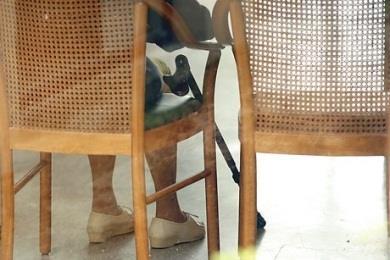Quality of life in care homes means encouraging outcomes that help to deliver dignity, respect and personalised care. Some clinical commissioning groups are leading the way through innovation

Every community has older people living in care homes with complex health needs, many of whom have more than one long term condition. What is more, 80 per cent of the care home population live with dementia.
‘A lack of physical activity puts people at greater risk of falls and other health complications’
Integrated and person centred care is accepted to be the best way to meet their needs, yet 441,000 older people living in nursing and residential care homes in the UK do not have the same access to occupational therapy and other multidisciplinary services as those living in their own home.
Good residential care is about more than providing a bed, attending to basic needs such as washing, dressing, toileting and administering medication; it must also provide opportunities for occupation – a fundamental human need.
- HSJ commission scoping report: Pave the way for better elderly care
- Improve frail elderly care with evidence, not intuition
- What Japan teaches us about better care for older people
Active help
Commissioning for the local population should take into account this highly vulnerable group who go into care homes for extra support, but not to relinquish the activities they enjoy.
There has been some progress in this area; the NHS employs in-reach teams, and the National Institute for Health and Care Excellence has launched new quality standards on mental wellbeing of care home residents, calling for more spontaneous and planned opportunities for people to participate in meaningful activity.
‘Activity is still seen as an add-on rather than something mandatory in care homes’
But although activity is included in the minimum standards for care homes, and forms part of care home inspections, it is still seen as an add-on rather than something mandatory.
A lack of physical activity puts people at greater risk of falls and other health complications, with social engagement influencing a person’s mortality to an even greater degree. The link between quality care that includes access to occupation and reduced demands on healthcare services is clear.
Case study: Southern Derbyshire CCG teaches with a toolkit
Southern Derbyshire CCG represents 57 GP practices and is responsible for the healthcare of 525,000 people.
The “Living well through activity in care homes” toolkit has been used to deliver the CCG’s care homes development programme, which supports 52 care homes in the area to deliver high quality care.
The CCG commissioned a pilot for an occupational therapist to deliver six training sessions, each based on a section of the toolkit. This is open to all nursing home activity coordinators to increase their knowledge and skills.
To date, the pilot has delivered three sessions and feedback has been positive.
Spotting the signs
Measuring and reviewing a person’s weekly occupation is also key to early intervention and prevention; less activity might be due to a lowering of mood, energy levels, infection or pain, and this enables staff to spot the signs of potential decline and decompensation before it occurs.
However, care home staff need more training and support to pick up these warning signs.
‘Commissioning outcomes should help to deliver dignity and respect’
Understanding how to adapt an activity so that someone can participate when they may have sensory impairment, frailty, limited range of movement, ongoing pain or discomfort, and cognitive impairment are skills that we cannot expect from care home staff.
Services need to be commissioned in a more innovative way, with a requirement to provide evidence of how they are supporting a care home to address all the key components of quality of life, health and wellbeing. GPs should be able to refer individuals to occupational therapists for specific advice and support to help address the barriers to engaging in daily living.
Commissioning outcomes should help to deliver dignity and respect, information and support and personalised care and choice, with measures capturing subjective health status, as well as functional status of care home residents.
Commissioning can require providers to demonstrate that:
- the care home’s policies, processes, training and leadership ensure a commitment to an activity culture;
- residents are enabled to participate in activities of their choice and staff have taken into account, but not excluded, on the basis of culture, age, gender, health, sexual orientation, disabilities and age related needs;
- there is access to community based activities and assistance is available if needed;
- the design of the communal space supports activity and social engagement and people are freely able to go outside into safe areas;
- the service can demonstrate access to multidisciplinary services that assess, advise and offer support to enable activity;
- safeguarding policies and practice ensure equipment is available and safely used to support people to engage in activity, and neglect is recognised when a person is deprived of both stimulation and company; and
- a monitoring process exists that places older people’s views at the heart of assessing quality of care. This would include interviews with residents and their nominated family member or friend.
Case study: Nightingale Hammerson encourages whole team to provide engagement ideas
The Nightingale Hammerson is one of the first care home organisations to pilot the new toolkit that supports the whole care home teams – from activity coordinators and care workers to housekeeping and gardeners – by providing ideas and tips on how to engage residents in day to day life.
They have observed the value of five and 15 minute activities that both enrich the experience and build relationships between staff and residents.
These short encounters help residents “live in the moment” and thereby contribute significantly to their quality of life and wellbeing.
In addition, the toolkit encourages residents to re-engage in domestic tasks and other activities that make up everyday life such as laying the table and hanging the washing. They are already seeing the difference this makes to residents’ wellbeing and mood.
Enabling occupation
A care home offering person centred occupation requires the right environment, equipment, training of staff and processes.
When thinking about a care home, many people will picture a communal room with residents sitting around the sides. The main activity in an older person’s day is to go into the communal lounge and sit, leaving only to use the toilet, eat lunch or return to their room.
When residents experience long periods of immobility, seating can become a health need. Poor positioning can cause skin to break down; pain and discomfort; joint stiffness; poor posture; fixed contractures; and increase the risk of falls. An older person’s independence can be influenced by their seating and positioning over the full 24 hours of a day.
‘Understanding the importance of seating and positioning can enable a resident’s awareness of what is going on around them’
Assessment for seating and positioning by an occupational therapist may only be commissioned for residents in receipt of continuing healthcare funding or a personal health budget.
However, expanding training and advice by occupational therapists would enable residents and care staff to understand:
- the importance of seating and positioning;
- how it can enable a resident’s awareness of what is going on around them;
- manage barriers to occupation;
- adapt tasks; and
- increase ability to take part in activities.
Toolkit support
A healthy care home requires support from the health and social care sector, which in turn can yield cost efficiencies for the whole health and social care economy.
The College of Occupational Therapists has produced the Living well through activity in care homes toolkit, as a new quality standard for meaningful activity in care homes.
Care homes will continue to be an important component of care provision for frail older people and for 20 per cent of over 85-year-olds; it is their permanent place of residence, their home.
‘Care homes can provide an environment for someone to thrive and activity is key’
They are part of their local communities and should not be left in a vacuum when it comes to proactive care. Care homes can provide an environment for someone to thrive and activity is key to people achieving good health and social care outcomes.
Some CCGs are commissioning new, innovative packages of care and others must embed occupation in order to measure health and wellbeing and reduce the risk of more costly healthcare interventions caused by falls, urinary tract infections and pressure injuries.
Karin Tancock is the professional affairs officer for older people and long term conditions of the College of Occupational Therapists



























No comments yet